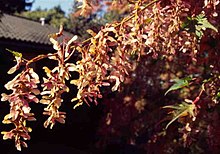|
Acer micranthum
Acer micranthum, the small-leaved maple,[2] is a species of flowering plant in the family Sapindaceae in the snakebark maple group, native to Japan, on Honshū, Kyūshū and Shikoku. Its Japanese name is the Komine maple.[3][4][5][6][7][8][9] It is a small, sometimes shrubby tree growing 6–10 m (20–33 ft) tall, with slender, arching branches. The bark is smooth and striped at first, becoming rough and dull grey on mature trees. The shoots and winter buds are dark purple-red. The leaves are 4–10 cm long and 2–8 cm broad, palmately lobed, with five deeply toothed lobes with long acuminate tips and double-serrated margins, and with distinctive tufts of orange-red hairs in the main vein axils at the base of the leaf; the petiole is 2–5 cm long. The leaves emerge red in spring and turn shades of yellow, orange and red[2] in autumn. The flowers are produced in early summer in racemes 4–10 cm long, each flower 4 mm diameter, with five yellow to greenish-yellow sepals and petals; it is dioecious, with male and female flowers on separate trees. The fruit is a paired samara with two rounded nutlets, each with a wing 1.5–2 cm long; the two wings spreading almost horizontally from each other.[3][4][5][6][8][10][11] It is most closely related to Acer tschonoskii, which replaces it further north and at higher altitudes in Japan; they have very similar leaf form.[8] Acer micranthum is cultivated as an ornamental tree in European and North American gardens, and has gained the Royal Horticultural Society's Award of Garden Merit.[2][12] Though hardy down to −20 °C (−4 °F), it requires a sheltered position in neutral or acid soil with sun or partial shade.
References
|
||||||||||||||||||||||||||||||||



